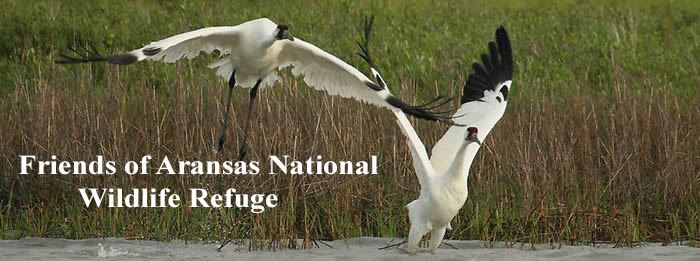Wade Harrell, U.S. Whooping Crane Recovery Coordinator
Whooping crane migration is nearly complete, with all of the marked birds having arrived in Texas by early this week. The birds appear to be heavily utilizing the coastal marsh right now, which is probably due to abundant food resources.
Whooping Cranes on the Refuge
Whooping crane tour boats and Refuge staff have been regularly reporting sightings of 25 or more whooping cranes along the marshes of the Blackjack Peninsula. Visitors should now be able to regularly see whooping cranes from the observation tower at the South end of the tour loop. This week a pair has been seen several times from the observation tower.
Texas Whooper Watch
We had several interesting reports during migration from Texas Whooper Watchers. Perhaps most interesting was a group of 19 whooping cranes spotted and photographed flying over Lake Waco on November 14th by Martin Kemper. Generally, whooping cranes migrate in smaller family groups. Perhaps as the population continues to grow, larger groups in migration will become more common.
A single subadult whooping crane, marked in Canada as a chick the summer of 2012, was spotted with a group of sandhill cranes on and around Brazoria National Wildlife Refuge in mid-November. This bird spent considerable time in Wharton County last winter and has now moved into Matagorda County.
A few other unmarked whooping cranes, including one confirmed family group, have been recently been spotted in Wharton and Matagorda Counties. They are using both agricultural areas and coastal marshes. This is a positive sign that whooping cranes continue to expand their winter range well beyond Aransas National Wildlife Refuge as the population expands.
We have had several inquiries as to whether there has yet been any whooping crane use of Granger Lake this winter. The two marked individuals that used the Granger Lake area last winter have both been around the Aransas Refuge most recently. Other than a quick stopover by one whooping crane in October, we haven’t documented any use of Granger Lake so far this winter.
Tracking Efforts
We are currently tracking 26 marked whooping cranes, and they are all now on the Texas coast. We have one more field season left to complete for the GPS tracking study and plan to mark 10 additional whooping cranes this January at Aransas.
Winter 2013-2014 Whooping Crane Research & Monitoring Initiatives
Our survey pilot is set to arrive on Monday and we plan on resuming our annual whooping crane wintering abundance aerial surveys next week as soon as the weather allows. We will fly a minimum of six surveys the month of December and should have preliminary results later in the winter.
Our new biological technicians have been traversing the state, recording habitat attributes at stopover sites that marked whooping cranes used during fall migration. A few of the counties they have visited include Baylor, Bosque, Childress, Hill and McLennan. They have documented a wide variety of habitat types that whooping cranes have used as stopover sites this fall, giving us new insight into preferred whooping crane habitat. Most of the stopover habitat evaluation for fall migration should be complete in the next few weeks and then the biological technicians will begin focusing on evaluating wintering locations.
Food Abundance
Significant whooping crane use of the coastal marsh thus far this winter indicates that estuarine food sources such as blue crabs are available right now. The Refuge's fire staff plans to burn a unit along the Blackjack Peninsula within the next week or so depending on weather.
Precipitation/Salinity
November was a dry month, with less than 1” of rain received at Aransas National Wildlife Refuge. Salinity levels in San Antonio Bay are currently around 26 ppt.
